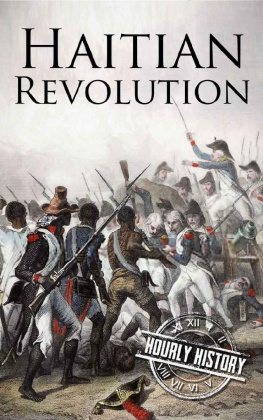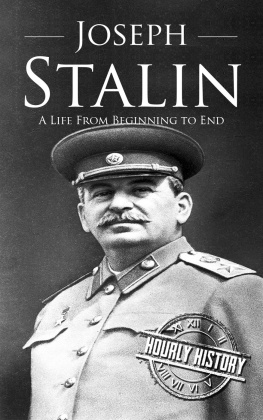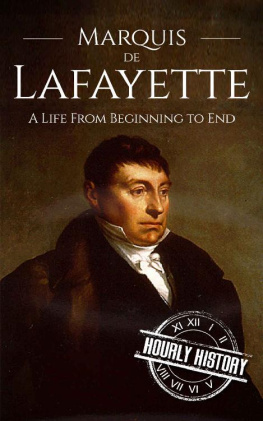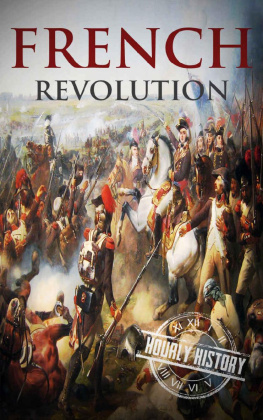Hourly History - Haitian Revolution: A History From Beginning to End
Here you can read online Hourly History - Haitian Revolution: A History From Beginning to End full text of the book (entire story) in english for free. Download pdf and epub, get meaning, cover and reviews about this ebook. year: 2016, publisher: Hourly History, genre: History. Description of the work, (preface) as well as reviews are available. Best literature library LitArk.com created for fans of good reading and offers a wide selection of genres:
Romance novel
Science fiction
Adventure
Detective
Science
History
Home and family
Prose
Art
Politics
Computer
Non-fiction
Religion
Business
Children
Humor
Choose a favorite category and find really read worthwhile books. Enjoy immersion in the world of imagination, feel the emotions of the characters or learn something new for yourself, make an fascinating discovery.
- Book:Haitian Revolution: A History From Beginning to End
- Author:
- Publisher:Hourly History
- Genre:
- Year:2016
- Rating:5 / 5
- Favourites:Add to favourites
- Your mark:
- 100
- 1
- 2
- 3
- 4
- 5
Haitian Revolution: A History From Beginning to End: summary, description and annotation
We offer to read an annotation, description, summary or preface (depends on what the author of the book "Haitian Revolution: A History From Beginning to End" wrote himself). If you haven't found the necessary information about the book — write in the comments, we will try to find it.
Haitian Revolution: A History From Beginning to End — read online for free the complete book (whole text) full work
Below is the text of the book, divided by pages. System saving the place of the last page read, allows you to conveniently read the book "Haitian Revolution: A History From Beginning to End" online for free, without having to search again every time where you left off. Put a bookmark, and you can go to the page where you finished reading at any time.
Font size:
Interval:
Bookmark:
Copyright 2016 by Hourly History Limited
All rights reserved.
Historians regard the late eighteenth and early nineteenth centuries as the Age of Atlantic Revolutions. Beginning in the thirteen British colonies of North America in 1776, revolutions broke out across the Americas and Europe. These were connected events; historians have shown how the ideas that sparked these revolutions traveled from place to place, and how average peoples as well as elites talked to each other about them across continents and national borders as much as across coffeehouse tables.
Perhaps none of these revolutions was as drastic as the Haitian Revolution. Haiti had been a French colony known as Saint Domingue for more than one hundred years when the revolution began. As in the United States previously and Mexico later on, the colonial government was overthrown, and a new nation with its own domestic government replaced the former colonial power. However, by the time it ended in 1804, the Haitian Revolution would completely overthrow the ruling class, abolish slavery, and challenge globally dominant ideas about race and power.
The Haitian Revolution also reverberated around the world in different ways than other revolutions. In almost all areas of the Atlantic World (Europe, Africa, South America, and North America), economies were dependent on slave labor and the slave trade. This had included Saint Domingue, Frances most profitable colony (and arguably the most valuable colony in the entire Caribbean). Saint Domingue primarily produced sugar cane, an incredibly labor intensive cash crop. Slaves were regularly worked to death, as thousands more arrived each year to replace those made victim to profit.
The Haitian Revolution eventually completely overthrew slavery and instituted an inclusive government largely run by former slaves. In some ways, this was unthinkable for those in power in the Atlantic world. But in other ways, this was the worlds biggest fear: in many places in the New World, black slaves outnumbered whites, and whites lived in fear that their chattel property would rise up, possibly killing them, but certainly upsetting the order of their lives. Saint Domingue, or Haiti, represented their worst fears come true.
The Haitian Revolution began as an offshoot of the French Revolution, and it is intricately tied to that event. However, it was certainly important in its own right. During the revolution and afterwards, its impact was felt around the world.
Present-day Haiti is one of the most historic places in the Caribbean. It is located in the western side of the island once called Hispaniola, so named by Christopher Columbus in 1492 on his first transatlantic voyage. After Columbus claimed it for Spain, the Spanish maintained control over it for more than one hundred years. During that time, they established plantations, began importing slaves, and decimated the indigenous Tano and Arawak population. However, the Spanish lost interest in Hispaniola, as they became increasingly concerned with their mainland American holdings, which were enriching the coffers of the state much more than the islands.
Partially in response to Spains neglect, French pirates began raiding as well as settling outposts around the island. Eventually, the presence of foreign ships became so threatening that Spain ordered all its subjects and citizens to relocate closer to the eastern city of Santo Domingo, abandoning the western side of the island (the Spanish also did not want to put out the effort to fortify the entire island). Close to the notorious pirate island of Tortuga, pirates of various national backgrounds and loyalties, but especially those beholden to France, established bases in western Hispaniola.
By the mid-1650s, the French monarchy would no longer ignore the abundant natural resources available on these Caribbean islands. Louis XIV officially colonized Tortuga and Saint Domingue in 1665, overcoming resistance from pirates who had laid claim to the islands. While Spain did not explicitly acknowledge the French presence on the island until the Treaty of Ryswick in 1697, they also never made any real attempts to regain it.
As the French consolidated control over their side of the island, their economy increasingly became dependent on agriculture. In the Atlantic world, agriculture meant slaves. Tobacco, cocoa, coffee, and most of all sugar were all cultivated, and required the labor of slaves. On sugar plantations especially, the brutal form of labor that proliferated on other Caribbean islands came to dominate. Put simply, it was more cost-effective for plantation owners (many of whom were absentee) to work their slaves to death and replace them with new African arrivals than it would have been to take care of their human property in order to prolong their life expectancies and allow them to regenerate their numbers through natural increase (live births).
As the years went on, Saint Domingue became increasingly valuable, and the exports it producedespecially sugarearned it the nickname the Pearl of the Antilles. By the time the revolution broke out in 1791, Saint Domingue was producing an obscene amount of sugar and coffee, representing an unthinkably disproportionate amount of the worlds supply relative to its population and size.
While wealthy whites maintained power and control in Saint Domingue, the population of the colony was very heavily African. However, not all of the peoples of African descent were enslaved. By the mid-eighteenth century especially, a very large community of free people of color grew on the island. As in several Caribbean colonies, men of European descent far outnumbered women. They frequently married or had children with women of color (sometimes these relationships were consensual and sometimes they were coerced or forced). While voluntarily freed slaves made up a small proportion of the people of colour on the island, most were the mixed-race children resulting from these relationships. White fathers frequently bestowed freedom, education, and property on these children, who eventually came to form an important class on their own.
In addition, a large number of runaway slaves also populated Saint Domingue. In response to the brutal conditions they faced, many enslaved peoples ran away. Since they were on an island, though, there were not many places they could run to. So, runaway slaves formed communities in the interior of the island, especially in the mountains, called maroon communities. Eventually, thousands of maroons populated the interior of the island, and many of them would fight for the end of slavery during the Haitian Revolution.
All French colonies lived under the French Kings Code Noir, which dictated the responsibilities of both slaves and owners. The original Code Noir was passed by Louis XIV in 1685. Despite these rules, however, atrocities were committed against slaves by their masters and their masters agents regularly. Rape and torture were common occurrences. Even when the worst kinds of human brutality were not unleashed, just the nature of work and discipline put thousands upon thousands of souls into an early grave. It was no wonder that so many chose to risk running away.
In 1751, a slave named Franois Mackandal became a maroon. He was a religious leader who had been born and raised in Africa, and became a leader in Saint Domingue. He united several maroon communities on the island, making them a large, formidable force that was committed to destroying slavery in Saint Domingue. He himself spoke of revolution and inciting slave insurrection, something that whites in slave societies everywhere feared above all else. He and his followers would frequently raid plantations, killing whites and free people of color and stealing food, livestock, and other supplies. In less than ten years, his followers killed more than six thousand people. However, he himself was captured and publicly executed (by being burned at the stake) in 1758 after plotting to poison the water supply of a very large community of whites and free people of color. The powerful elites in Saint Domingue recognized the threat of slave insurrection, and lived in fear of it as much as any other slave society.
Font size:
Interval:
Bookmark:
Similar books «Haitian Revolution: A History From Beginning to End»
Look at similar books to Haitian Revolution: A History From Beginning to End. We have selected literature similar in name and meaning in the hope of providing readers with more options to find new, interesting, not yet read works.
Discussion, reviews of the book Haitian Revolution: A History From Beginning to End and just readers' own opinions. Leave your comments, write what you think about the work, its meaning or the main characters. Specify what exactly you liked and what you didn't like, and why you think so.











